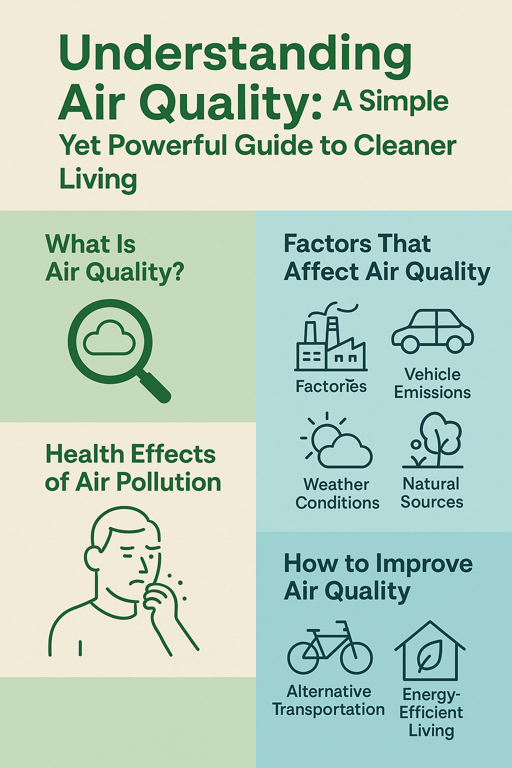Introduction
Air is something we can’t live without, yet we often take it for granted. Every breath we take affects our health, mood, energy, and even our lifespan. But what if the air you’re breathing is harming you slowly without you knowing it? This is why air quality matters more than ever today.
In this blog post, we’ll break down everything you need to know about air quality in the simplest terms possible.

What is Air Quality?
Air quality refers to how clean or polluted the air around us is. Good air quality means the air is clean and safe to breathe. Poor air quality means it contains pollutants that can harm our health and the environment.
To measure air quality, scientists use something called the Air Quality Index (AQI). It’s a scale from 0 to 500:
- 0–50: Good
- 51–100: Moderate
- 101–150: Unhealthy for sensitive groups
- 151–200: Unhealthy
- 201–300: Very Unhealthy
- 301–500: Hazardous
The higher the AQI, the worse the air.
What Pollutes the Air?
Several things can pollute the air, including:
1. Vehicle Emissions
Cars, trucks, and buses release gases like nitrogen dioxide and carbon monoxide.
2. Factories and Power Plants
They burn fossil fuels and release sulfur dioxide, carbon dioxide, and other harmful chemicals.
3. Construction Dust
Sand, cement, and bricks produce tiny particles that float in the air and enter our lungs.
4. Agricultural Activities
Use of pesticides and burning of crop residue releases chemicals and smoke.
5. Indoor Pollution
Smoke from cooking, mold, dust mites, and pet dander can pollute indoor air.
6. Natural Sources
Volcanoes, forest fires, and dust storms can also cause air pollution.
Types of Air Pollutants
Here are some major pollutants you should know about:
- PM2.5 and PM10: Tiny particles that can enter your lungs and bloodstream.
- Nitrogen Dioxide (NO2): Comes from cars and industrial processes.
- Sulfur Dioxide (SO2): Mainly from coal-burning power plants.
- Carbon Monoxide (CO): A deadly gas from vehicles and heating systems.
- Ozone (O3): Good in the upper atmosphere but harmful near the ground.
How Poor Air Quality Affects Your Health
Bad air doesn’t just cause coughing or sneezing. It can lead to serious health issues like:
- Asthma and lung problems
- Heart disease and strokes
- Fatigue and headaches
- Premature aging and skin issues
- Reduced brain function
- Early death in severe cases
Air Pollution and Climate Change
Air pollution doesn’t just affect us—it affects the planet. Greenhouse gases like carbon dioxide (CO2) trap heat, leading to global warming. Smog and black carbon change weather patterns, melt ice, and affect crop production.
Improving air quality also helps in fighting climate change. When we reduce emissions, we protect both our health and our planet.
How to Check Air Quality in Your Area
You can check air quality using websites or apps like:
- AQICN.org
- AirVisual
- Plume Labs
- Government weather apps
Look at the AQI and try to avoid outdoor activity when levels are high.
Simple Ways to Improve Air Quality
Here are some actionable steps you can take today:
1. Use Public Transport or Carpool
Reduces the number of vehicles on the road.
2. Plant More Trees
Trees absorb carbon dioxide and release oxygen.
3. Avoid Burning Trash
Burning waste releases toxic fumes. Use proper waste disposal methods.
4. Use Eco-friendly Products
Switch to products with fewer chemicals—like natural cleaners and low-VOC paints.
5. Maintain Your Vehicle
A well-maintained vehicle emits fewer pollutants.
6. Avoid Smoking Indoors
It pollutes the indoor air for everyone.
7. Use Energy Wisely
Switch off lights and fans when not in use. Use energy-efficient appliances.
8. Support Clean Energy
Choose solar, wind, or hydro energy sources if possible.
Role of Governments and Policies
Governments around the world are taking steps to improve air quality:
- Setting emission limits for factories and vehicles
- Promoting electric vehicles
- Investing in public transport
- Creating green spaces
- Banning harmful fuels and chemicals
Policies like India’s National Clean Air Programme (NCAP) and international efforts like the Paris Agreement are major steps in the right direction.
Future of Air Quality: Hope with Technology
Technology is helping fight air pollution through:
- Air purifiers and smart sensors
- Green buildings and eco-friendly urban planning
- Electric and hydrogen vehicles
- AI-powered pollution monitoring
With awareness, innovation, and collective action, we can breathe cleaner air in the future.
Final Thoughts
Improving air quality is not just the job of the government or scientists. It starts with you and me. Small changes in our habits can lead to big changes in our world.
Breathe better, live better.
Next Steps
- Follow our DevOps tutorials
- Explore more DevOps engineer career guides
- Subscribe to InsightClouds for weekly updates
- Subscribe our DevOps youtube channel